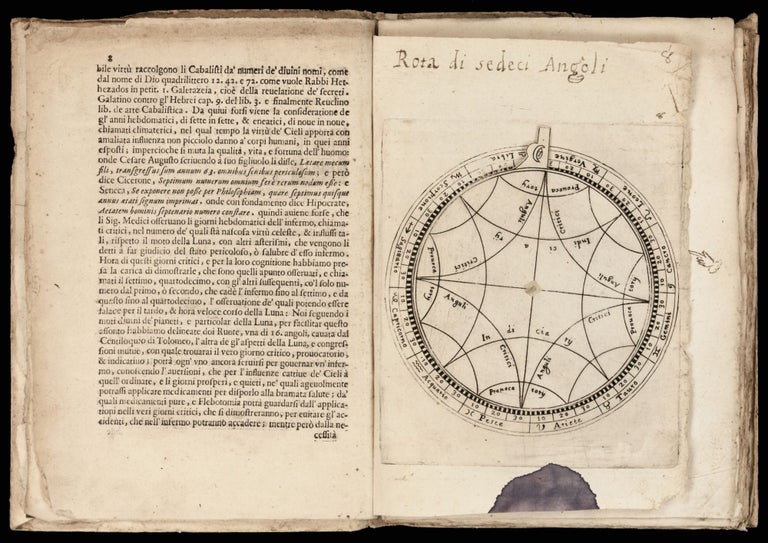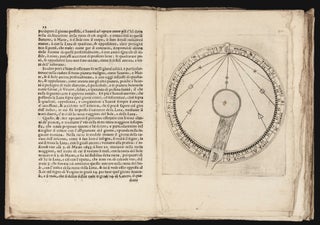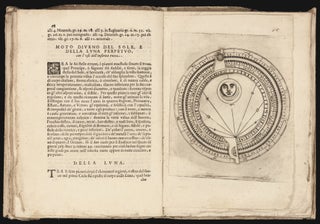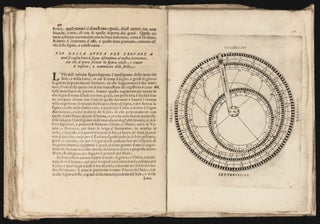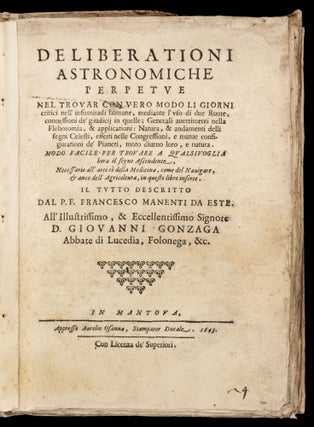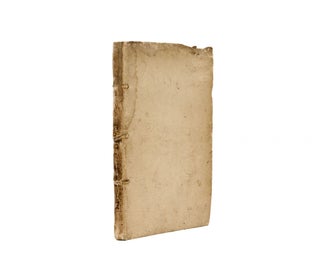Deliberationi astronomiche perpetue nel trovar con vero modo li giorni critici nell’infirmitadi humane, mediante l’uso di due ruote, connessioni de’giudicii in quelle.
4to. [23.2 x 17.0 cm], 98 pp., (3) ff., with (4) ff. full-page engraved plates, each complete with working volvelles, woodcut headpieces and initials. Bound in contemporary cartone. Chipping to spine, rubbing and edge wear to boards, minor loss at top edge of boards, staining to lower board. Occasional mostly marginal staining and toning, spotting to a few leaves, marginal paper flaw at p. 47, a few contemporary annotations. Very rare first and only edition – illustrated with 4 ‘paper instruments’ complete with their volvelles – of this understudied early 17th-century treatise on astrological prognostication, a work of some note for its recognition (and acceptance) of recent groundbreaking telescopic discoveries made by Galileo Galilei (1564-1642) and others. Published in Mantua by a certain Francesco Manenti da Este, the Deliberationi astronomiche perpetue is devoted to determining ‘critical days’ (favorable and unfavorable days) for medicine (e.g., bleeding), judicial proceedings, and navigation, for dates between its 1643 publication and 1655, but Manenti here adds to the speculation about the future a rather sophisticated knowledge about the most current astronomical practices. Manenti does not directly address cosmology per se, but in his comments about the planets he shows a familiarity with rather recent (and controversial) telescopic observations made by Galileo. Manenti, who apparently subscribed to a Tychonic system (remarking that Saturn, Jupiter, Mars, Venus and Mercury all orbit the sun), notes that, when observed through a telescope (“Telescopio”), Jupiter is “followed by four stars which are not fixed, but wandering” (p. 44), a clear reference to Galileo’s 1610 discovery of the ‘Medicean’ moons as reported in his Sidereus Nuncius (1610), an observation of great importance for the advancement of Copernican heliocentrism in that, “the circulation of four stars around Jupiter showed that heavenly bodies could indeed revolve around centers other than the earth” (Drake, p. 157). Manenti was also aware that Saturn had “two rather small stars which always accompany it” and that these three bodies sometimes coalesced to give the appearance of an oval (p. 39), a remark which refers to Galileo’s telescopic observations of Saturn’s ancillary ‘stars’ (rings) made between 1610 and 1616. Saturn became a topic of much debate among astronomers from the 1640’s and continued to be so for years after Christiaan Huygens (1629-95) recognized in 1659 that these ‘small stars’ were in fact rings. Much of Galileo’s work on the Saturn problem remained unpublished during his lifetime (he refers obliquely to the matter in the 1623 Il Saggiatore), and other astronomers who observed the planet in the 1630s (Francesco Fontana, Gassendi, Hevelius) would not publish their findings until the after 1645, so it remains a matter of speculation as to how Manenti received his information. Intriguingly, Manenti was also apparently aware of observations of the phases of Mars, Venus and Mercury, as he states unequivocally that these three bodies “receive the light of the sun” (pp. 48, 54, and 60). The pure geocentric system of Ptolemy would not support such observations. Galileo had seen the phases of Venus in 1610, noting his findings in the 1613 Istoria e dimostrazioni intorno alle macchie solari, and illustrating the phases in Il Saggiatore. Galileo inferred that Mars and Mercury should also exhibit phases, suppositions that were confirmed in telescopic observations made by Francesco Fontana and Giovanni Battista Zupi in the 1630s. Manenti dedicated his work to Giovanni Gonzaga (d. 1645), son of Vincenzo II Gonzaga, Duke of Mantua (1594-1627), whose position at the waning of Gonzaga influence in Mantua perhaps inclined him toward an interest in predicting the future. The volume’s engraved ‘paper instruments’ were to be used in conjunction with planetary data and astrological ‘aphorisms’ gleaned from the ancients and other ‘filosofi’. The Deliberationi astronomiche perpetue “contains four volvelles: one (with one disk) to correlate critical days of the signs in the zodiac, one (two disks) to do the same with the phases of the moon, one (two disks) again involving the sun and moon and one (two disks) that is essentially the zodiac circle from the rete of an astrolabe, used for determining the position of the sun and hence the time of day. This last volvelle is unusual in that it shows both twelve-hour and twenty-four-hour notation for time” (Tomash & Williams). Francesco Manenti da Este, who is little recorded elsewhere, apparently wrote no further works, and further research on this figure might provide a more complete picture of how Galileo’s new methods and observations were received and disseminated in the first half of the 17th century. OCLC locates U.S. examples of Deliberationi astronomiche perpetue at UCLA, Adler Planetarium, Yale Medical, and Oklahoma. * Riccardi I.78-79; P. L. Pizzamiglio, L’astrologia in Italia all’epoca di Galileo Galilei, 1550-1650, p. 238-40; Tomash & Williams M30; USTC 4017727; Siraisi, Medieval and Early Renaissance Medicine, pp. 135-36; G. Vedova, Biografia degli scrittori padovani, vol. 1, p. 564; S. Drake, Galileo at Work; J. L. Heilbron, Galileo.
Sold

